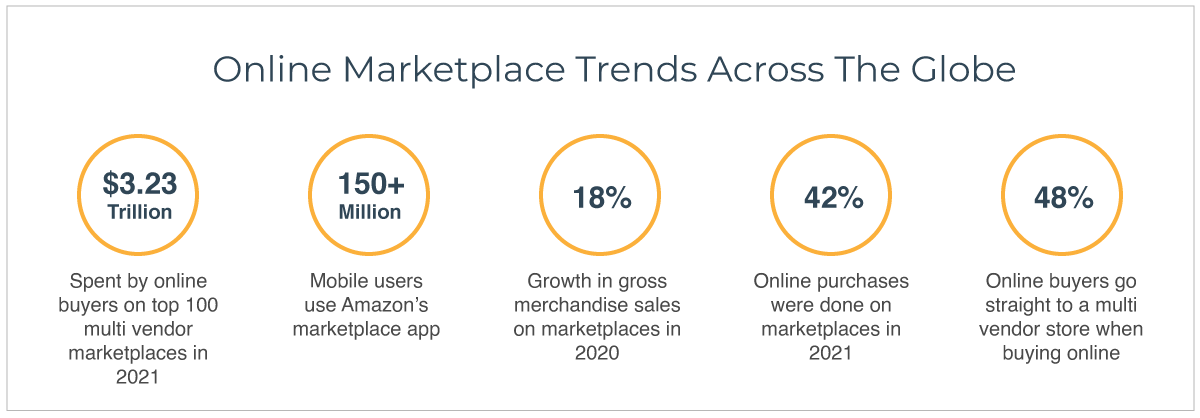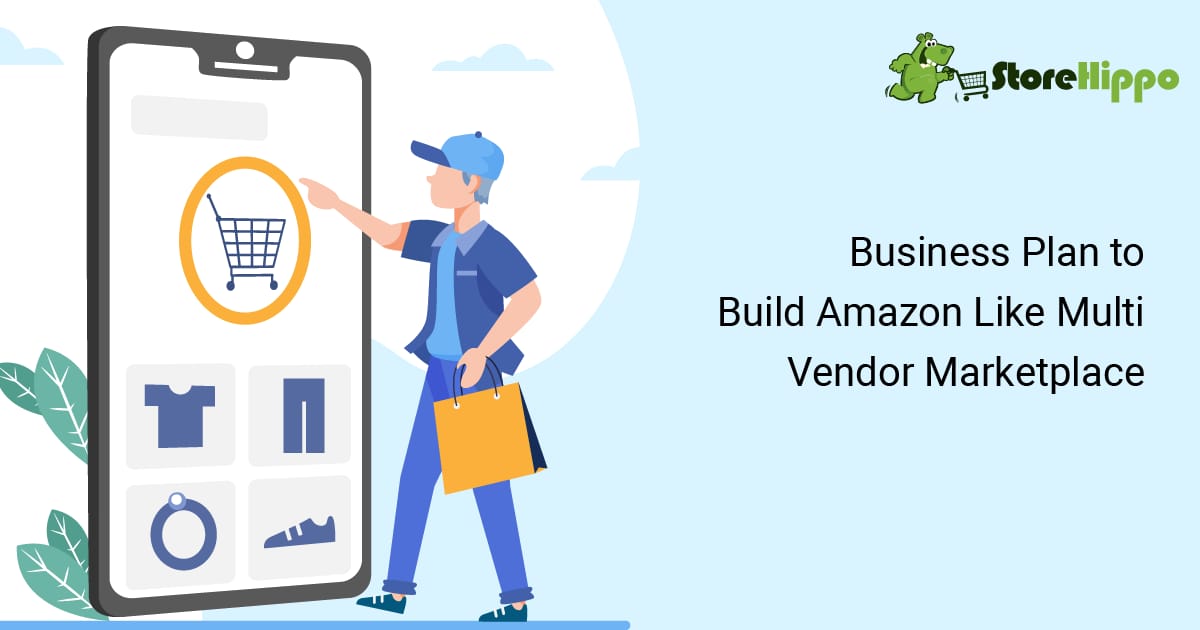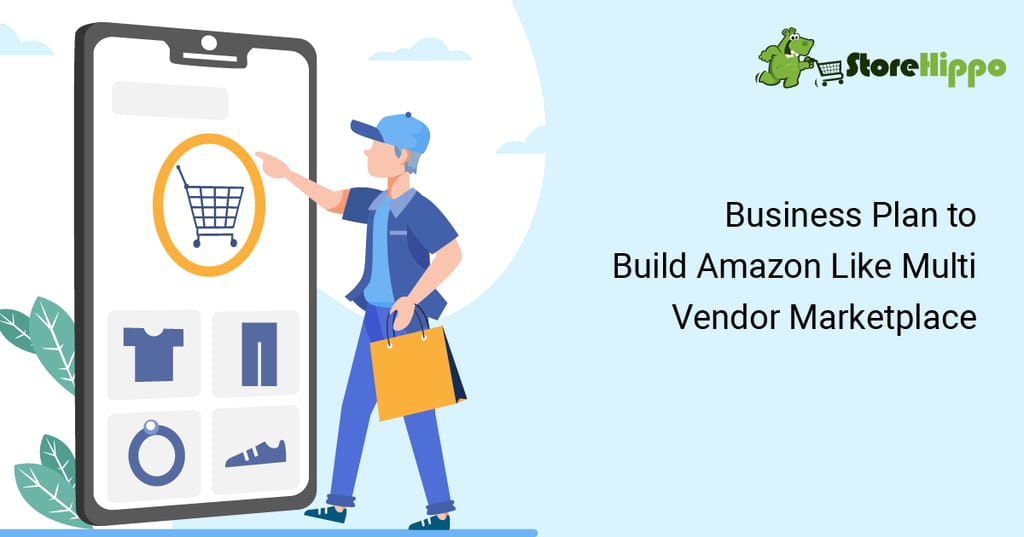When we think of a multi vendor ecommerce website, we think Amazon.
Such is the massive growth and popularity of the brand that it has literally metamorphosed into being a search engine for products rather than just being an online marketplace.
With a humongous catalogue of over 350 million products and services (including Amazon’s as well as sellers’ products), Amazon literally sells everything needed by everybody.
Amazon’s popularity and growth prove one point for sure, it’s a business model worth considering.
Table of Contents
- Multi Vendor Marketplace: An Idea Whose Time Has Come
- Online Marketplace Trends Across The Globe
- Why Enterprise brands should start an online marketplace platform
- Steps to Start an Online Marketplace Platform Like Amazon: A complete business plan
- Step 1 - Market study to identify the need and supply gap
- Step 2 – Choice of target audience and geography
- Step 3 – Vendor onboarding for your marketplace
- Step 4 – Documentation and domain registration to start the business
- Step 5 – Finding the right ecommerce marketplace solution to build your multi-vendor marketplace
- Step 6 – Selecting the business model (B2B or B2C)
- Step 7 – Cost to start an online marketplace platform
- Why Choose StoreHippo to start an online marketplace platform?
- Conclusion
Multi Vendor Marketplace: An Idea Whose Time Has Come
Ecommerce sales have breached all previous growth records in the past few years. In 2021, Global retail ecommerce sales stood at $4.9 trillion in 2021. Ecommerce sales are forecasted to grow by 50% and reach $7.4 trillion by 2025.
What’s even more interesting is the fact that online marketplaces hold the top position when it comes to attracting, converting and retaining online buyers. Here are some figures to give a better understanding of how marketplaces have changed online buying.
Online Marketplace Trends Across The Globe
Let's look at the ongoing online marketplace trends being recorded around the world:

$ 3.23 trillion spent by online buyers on top 100 multi vendor marketplaces in 2021
150+ million mobile users use Amazon’s marketplace app
18% growth in gross merchandise sales on marketplaces in 2020
42% of online purchases were done on marketplaces in 2021
48% online buyers go straight to a multi vendor store when buying online
Source: Digital Commerce 360
Well, its clear from the figures that buyers love the huge catalog and ease of buying offered by multi seller stores. What’s even more noteworthy is the fact that the no-inventory marketplace model is a lucrative business idea for enterprise brands.
Why Enterprise brands should start an online marketplace platform
Scaling a retail business amidst a million other businesses can be quite challenging unless your brand offers products and services like none other. So, the smartest way out to stay in the market and still keep customers flocking to your brand is to spoil them for choice.
And how exactly can an enterprise brand do it?
You guessed it, start an online marketplace platform.
While multi-seller stores give you the power of plenty, they also help you diversify and add newer revenue sources. Here are a few compelling reasons to get started with your own Amazon-like store:
Online marketplaces are an improvement over online stores and engage customers better
Easy to build a rich-catalog by onboarding vendors selling diverse products
Sclaing is easy to new product lines or geographies by onboarding new sellers
Zero inventory cost as it is taken care by the vendors
Easy to get started by choosing one of the advanced marketplace builders
Strategic business insights with huge customer and vendor data at disposal
Opportunity to launch brand’s own products or services line to boost brand value and revenue sources
Scope for pivoting to hyperlocal ecommerce, quick commerce or other disruptive hybrid business models
Steady earnings with commission on every order
Opportunity to introduce ads, positioning, preferred partner status etc. to multiply revenue sources
With so many benefits to offer, building a multi vendor ecommerce website like Amazon is definitely an idea worth considering for fast-growing enterprise brands.
Steps to Start an Online Marketplace Platform Like Amazon: A complete business plan
Building an online marketplace becomes much easier and smooth if you already have a well charted step-wise plan for different stages of business set up. So here we present a simple blueprint to get you started with your Amazon like store.
Step 1 - Market study to identify the need and supply gap
Timing of launching your online business is everything. Like, the best time to start an ice-cream brand is during the summer season.
So, the first step to launch your online marketplace is to identify the gap between need and supply. Accordingly, choose your business niche and the launch time. The most preferable time to launch your business is when the demand is excessive and supply is limited. it will help you create a strong foothold in the market.
Step 2 – Choice of target audience and geography
Now that you are sure about your business niche, choosing your target audience and market geography should be the second step. Well, you cannot expect people to buy from your multi vendor marketplace if you don’t know who you are selling to. Some of the quick questions you ask are:
- What is your online store all about?
- Who are the customers seeking for your business offerings?
- What does your online store represent?
- Who are your ideal customers?
- What is the most preferable geography for your business?
Once you have identified the target audience and geography for your business, you can make an online store look perfect according to the expectations of your prospective customers.
Step 3 – Vendor onboarding for your marketplace
If you are aiming to start an online marketplace platform like Amazon, you should think scalable and profitable right from the start. Vendors are your indispensable assets and they are the ones who drive your online marketplace.
For the same reason, the onboarding of vendors is a very important step. You will face a lot of competition in selling products online, so find the vendors who can offer the best quality and best prices. It’s not all, easy and quick vendor onboarding is also very important. With StoreHippo, you can onboard multiple vendors easily by offering a simple registration process and ensure to bring true value to the market.
Step 4 – Documentation and domain registration to start the business
Now, it is the time to go ahead with one of the most crucial parts of starting an online business – registering and completing the legal formalities.
- Apply for the director’s identification number with necessary documents
- Ensure your Permanent Account Number (PAN) and Digital Signature Certificate
- Decide the company name
- Apply for the company name registration
- Register the domain for your business website
- Apply for the Goods and Service Tax (GST) certification
Step 5 – Finding the right ecommerce marketplace solution to build your multi-vendor marketplace
While you are building a multi vendor marketplace, you can choose to build a website from scratch or build it with a fully-hosted and managed ecommerce solution.
So, let’s talk about the difference between building from scratch and a pre-built ecommerce platform. There are many advantages of pre-built platforms over building your own website. Some of them are:
- Saves a lot of money
- Saves the hiring of IT resources
- Automated marketing solutions
- Integration of payment and logistics
- Mobile-friendly
- Vendor and customer management at a central place
- Ready-made beautiful website themes for your business, and a lot more.
For example, if you deal with online fashion, you can choose a colourful website with a lot of space to accommodate visual content. You will not need to waste your time and resources on building the website from scratch. With StoreHippo, you can simply play around the ready-made themes, technology, and solutions that can help you achieve online success.
Step 6 – Selecting the business model (B2B or B2C)
If you are thinking to start an online marketplace platform, selecting the business model holds the utmost importance. The B2B marketplaces require enterprise-grade features and B2B features to streamline and automate the business processes. Features like RFQ, MOQ, multi-pricing etc. are essential for B2B brands. While B2B marketplaces also need easy to use dashboards for manufacturers, distributors, brand owners, and retailers so all involved partied can work in tandem to ensure an efficient business.
On the other hand, the B2C marketplaces require more user-friendly features and elastic scalability to handle the peak load of sales and promotions and festive seasons. Enterprise brands can also choose the B2B2C model, whereby they partner with other businesses and onboard them as vendors to serve the end customers.
Whether you decide to build a B2B , B2C or B2B2C business model, StoreHippo can help you big time. It has already built many successful stores that have helped the clients to set up, manage and succeed in their online businesses.
Step 7 – Cost to start an online marketplace platform
Simply said, you need not incur heavy costs to start an online marketplace platform if you have chosen to build it on StoreHippo. Still, some of the factors to be considered are:
- Choice of business models (B2C, B2C, or any out-of-the-box model)
- Project complexity and customizations
- Choice of the solution – custom-built, turnkey solution with plugins, fully-hosted and managed multi-vendor solution
- Additional requirements like mobile apps etc.
One of the most common reasons for the popularity of the online marketplace on ecommerce platforms is its low setup costs. And another benefit is the win-win condition for all the parties i.e. marketplace owner, sellers, and customers. Don’t think any more about building your marketplace website with StoreHippo. Check out the different pricing plans for your multi-vendor marketplace now.
Why Choose StoreHippo to start an online marketplace platform?
With a cutting-edge turnkey marketplace solution like StoreHippo brands can build and launch their Amazon-like marketplace in record time. StoreHippo offers a plug and play marketplace builder that is built on MACH architecture. The scalable and extensible StoreHippo platform comes loaded with over 300 inbuilt features and 120+ integrations. With the power and agility of MACH architecture and StoreHippo rich set of features enterprise brands can start an online marketplace platform tailor-made for their requirements.
Going omnichannel is easy StoreHippo. StoreHippo’s pure headless solutions enable brands to add new customer touchpoints using the same APIs and backend logic.
StoreHippo offers a comprehensive vendor management solution along with support for different business models like multi-store ecommerce, multilingual, D2C, B2B, B2B2C, hyperlocal ecommerce, quick commerce etc. to help brands mix multiple models and create their unique multi vendor marketplace.
The PCI DSS compliant StoreHippo multi seller ecommerce platform offers inbuilt mobile apps builder to build Android and iOS marketplace apps. StoreHippo also has 60+ integrated payment gateways and 30+ shipping partners to help with streamlined fulfilment. The inbuilt marketing tools help in running a variety of promotions to grow the marketplace business.
Conclusion
The online marketplace model is going to metamorphose into advanced hybrid multi vendor marketplace models in the years to come. From hyperlocal commerce to service aggregators, we are already witnessing the change brought by marketplaces. Building an online marketpalce can give enterprise brand’s a winning edge over competitiors and future proof their brand.
Ready to explore the exciting world of multi seller ecomemrce stores? Want inspiration? Check out our successful case studies of clients who have build their own unique multi seller stores. Explore the rich features of StoreHippo multi vendor marketplace platform by starting your 14-day free trial now.





















5 Comments
Leave a Reply
Leave a Reply
Leave a Reply
Leave a Reply
Leave a Reply